Common Species

1. Potamotrygon motoro
Common names: Ocellated River
Stingray, Spotted River Ray
Motoro rays are one of the most commonly traded freshwater rays, This is because they are very hardy, easy to feed, and easy to breed—hence, they are dubbed the “beginner ray.”
Sexual maturity is reached at 12 inches, depending on the collection point. They are found in nearly every river basin in South America. They can reach up to over 30 inches in size, with the females being larger.
In my experience, they tend to whip their tails when captured more often than other FW rays, so extreme caution is advised. There are several morphs and variants of the Motoro but there is one which is very popular yet is often mistaken for another species: the Marbled Motoro.
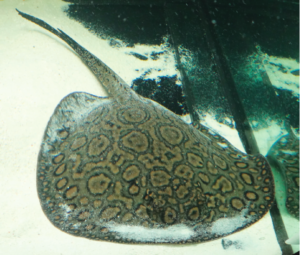
2. Potamotrygon sp. “Mantilla”
Common Name: Mantilla Ray
The Mantilla ray has very random, scrawl-like markings. Honestly, I that if you mix some Motoros, Marbleds, and Pearls, you’ll get a ray that will look like a Mantilla. The name originated from a fish distributor from Florida named Jose Mantilla.
It is a bit smaller, but (based on my experience) as hardy as the P. Motoro. A few years ago they are traded at cheaper prices than their ocellated (having eye-like markings) counterparts, but due to the increase in locally bred Motoros, Mantillas are now sold at higher prices, sometimes even at twice the price of a Motoro. It is also believed that these rays are wild ones that hybridized in a certain branch of the Amazon river.

3. Potamotrygon reticulata
Common Names: Reticulated River Ray, Teacup Ray, Colombian Ray
This is considered one of the smallest FW stingrays, along with the Hystrix. It usually reaches sizes of 14 inches, though the females get larger. Potamotrygon reticulata is one of the most often misidentified stingrays in the aquarium hobby. It is often exported and imported as the ‘Teacup’ Stingray, a generic term used for a juvenile stingray with no dentification.
Found in the Magdalena and Atrato rivers in Colombia. P. reticulata tend to be very finicky eaters, especially when juvenile. As for me, I fed them Tubifex at first, then eventually trained them to eat minced market prawns and tawilis.
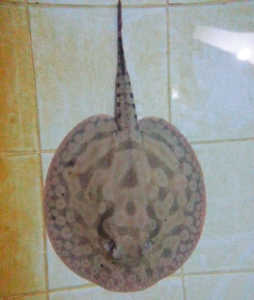
4. Potamotrygon hystrix
Common Names: Porcupine River Ray, Teacup Ray, Cururu River Ray, “True” Hystrix Stingray.
As mentioned earlier, this is considered one of the smallest FW stingrays, along with the Reticulata; like the former, they often reach 14” in size, with the females growing larger.
Found in Rio Negro, Brazil, and Peru, they can easily be fed but are hard to find nowadays because they are banned from export in Brazil, so what we can get is the Peru version. In the Philippines, the only adult Hystrix I’ve seen belonged to Jaime Lim.
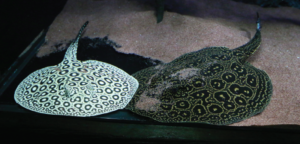
5. Potamotrygon sp. “Pearl”
Surprisingly, there is little information about Pearls. In some forums, it is believed (though not verified) that they came from the Rio Tapajos in Brazil, though they are now widely bred in Asia.Variants of this beautiful brown ray include the dark base, white base (White Pearl), and the 5-star.
In my experience, my Pearl reached sexual maturity at around 15 inches and is easily impregnated. It is as hardy as my Motoros and easily fed. (Manny Bautista)
Meet the Monster Rays

1. Potamotrygon castexi
Common Names: Vermiculate River stingray, Otorongo Ray, Jaguar Ray, Estrella Ray, Star Ray, Tigrinus Ray, Tigrillo Ray, Carpet Ray, Motelo Ray, and Tortoise Ray.
This is the Monster ray you should be afraid of. With powerfully built tail that is noticeably longer than its body, one whip will surely be a memorable one. It grows to about 30” with the females growing larger. Some say it can reach up to 36 inches. It can be found in Upper Amazon river basin (particularly the Guaporé, Beni, Solimões, and Marañon rivers) and the Paraná-Paraguay basin. It is restricted to Argentina, Bolivia, Brasil, Paraguay, and Peru.I have observed that it has the same tolerance to different water parameters as the P. Motoro. My Castexi is the most aggressive feeder among my rays. This species can be easily fed with anything and grows very fast; that’s why you should prepare for bigger housing if ever you decide to get one.
Purchasing one is the tricky part; when it comes to pups, the Potamotrygon reticulata has very similar patterns, but the two can be differentiated by the single horizontal line running laterally along the tail, so make sure you are buying the giant because you might end up buying the dwarf instead.In the aquarium trade, Vermiculate River stingrays are broken down into at least 5 ‘variants’, according to their patterning:
• Otorongo Ray (Jaguar Ray): Displays a dense covering of light spots that sometimes form an almost solid mass towards the center of the disc. The outermost spots are more defined and more broadly spaced.
• Tigrinus Ray (Tigrillo Ray): Similar to the above, but the orange spots fuse to form a lattice of interconnecting broken shapes. Lighter outer spots are more defined and separated.
• Estrella Ray (Star Ray): Less densely covered in spots, this results in a ‘starry’ appearance. Its central spots sometimes form clusters.
•Motelo Ray (Tortoise Ray): Its markings are similar to those of the Otorongo pattern, but the densely covered spots form distinct closely grouped clusters, resulting in a honeycomb appearance or one that resembles the plates on a tortoise’s back (but more numerous).
•Carpet Ray: This is completely covered in light broken circles (formed from spots) and spots on a dark background.
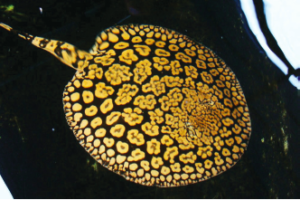
2. Potamotrygon schroederi “Colombia”
Common Name: Flower Ray
If they were to be described by one line, it would be, “Looks can be deceiving.” This is one of the FW rays with the most beautiful pattern. But be cautious. Despite attaining sizes of 36” or more, this ray is a very finicky eater and is sensitive to different water parameters. It can be found in the Apure River, the Orinoco basins, Venezuela, and Colombia. It’s not as expensive as the Black rays, so if anyone is up for a challenge, this one is the perfect specimen.
The Black Rays
First off, let me start by saying, “Come to the Dark Side.”
Currently, only two species of black rays—namely the P. leopoldi and P. henlei—are scientifically recognized species, There is a third, unrecognized species, referred to as the Itaituba river stingray, or as it is commonly called, the Itaituba or P14. A variant of the Leopoldi, called the “Black Diamond,” is a much-coveted stingray. The following descriptions may help you distinguish among the four species:

1. Potamotrygon henlei
Common names: Spotted River Ray, Orange Blotched River Ray, and most commonly, The Big-Tooth River stingray.
In our country, this is the most unpopular among the four black rays because of its dark brown base coloration and medium off-white spots. May possess small spots near the outer edge of its disc. It usually grows to 24”, with the females growing larger. They can be found in the Tocantins River system, particularly the Tocantins and Araguaia in Brazil.
In my experience, they have the same tolerance as the P. Leopoldi when it comes to water parameters. It is a finicky eater at first but it will eventually accept market prawns and tawilis.

2. Potamotrygon leopoldi
Common names: Xingu River Ray, White Blotched River stringray, and Polkadot Ray
Unlike the Henlei, Leopoldis have a black base coloration, with few large white spots on their bodies, and short, paddle tails. Leos start out as gray pups, and they turn black with white spot patterns as they mature. Most specimens have triangular spot formations found on their backs, and these are commonly termed by hobbyists as the “3-2-1” formation. Leos can be found in the Xingu River in Brazil. For me, unless your BD is exceptional, my eyes are on a pure Leo with few very large white spots.
3. Black Diamond “BD”
Some consider this a separate black ray from the Leopoldi, but they are in fact just a variant of the latter.Because of its intense white on black color contrast, BDs are the most sought-after rays by hobbyists with very deep pockets in our country.Characteristics of the Black DiamondAlthough the Black Diamond does not have an official description, these are the most desirable aspects of its appearance:- Brighter white spots on the disc (in a consistent pattern)- Edge-spotting (spots around the edge of the disc)- Belly spotting (dark black/dark gray spots at the bottom of the disc at a later age)- The base black color is more intense- Usually, the iris of the eye is white There are three subcategories of the Black Diamond stingray:

• Thousand Island: often referred to as T1. This variety has many bright spots on the disc, with some larger spots in the middle.
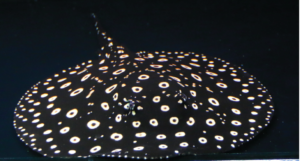
• Eclipse: its pattern has evolving spots that turn into bright white rings filled with black spots. Often these rings form unique shapes like arcs and lines.
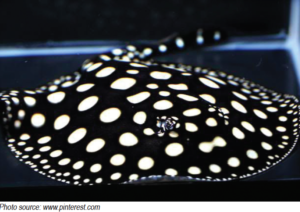
• Big Spot: its pattern has large bright white spots that do not have any of the characteristics of the Eclipse or Thousand Island varieties.
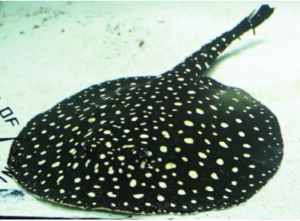
4. Itaituba river stingrays
Common names: Galaxy Ray and Black Estrella Ray.
The yet-to-be-classified P14 rays are said to be different from the Henlei and Leopoldi rays, although some people feel that it is only a variant of the leopoldi, due to the proximity of the Itaituba and Xingu rivers. They are endemic at Rio Tapajos, the Xingu River basin, Itaituba, Brazil.They can be easily distinguished from the Leopoldi by their differentiated spot patterns (small white evenly scattered spots) and extra spotting around the disc margin, smaller maximum size, and a mottled underside. There are also two variants of the P14 rays. The normal Galaxy rays have numerous smaller white spots while the Royal galaxy variants have larger spots.
Furthermore, unlike the Leopoldi, they start out brown and turn black slowly, and they only grow up to a size of 18”. A factor worth considering in keeping a Galaxy are the changes in its appearance that you get to see as it grows from pup to adult.One more aspect to identify the P14 is that the barbs wrap around the tail area, resembling a cactus. This is unique to the P14, as the Henlei and Leopoldi’s barbs occur on the top side of the tail only. Although, in my experience, it is the most sensitive among the Black rays, it is still a fish worth every peso.
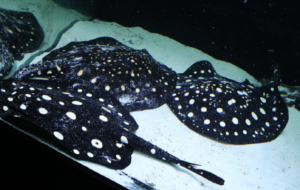
Batman Rays
Although this is not a species but are in fact genetic accidents, I have to clarify some things since some people have the absurd idea that these birth defects can (and should) be replicated. First of all, these so-called “batman” rays are not man-made and cannot be reproduced by slicing the disc of these sensitive animals. Stingrays have the ability to regenerate their discs, so one will just regrow its disc if ever it survives the mutilation.
These stingrays command a very high price due to their rarity, but there are special considerations for their keeping. You could compare them to humans who have only one foot or one hand. Batman rays have difficulty holding on the surface of aquariums with their special fins. They also have difficulty competing for food and are more prone to injury from aquarium decorations.
This appeared as part of “50 Shades of Ray” in Animal Scene’s August 2015 issue.






